
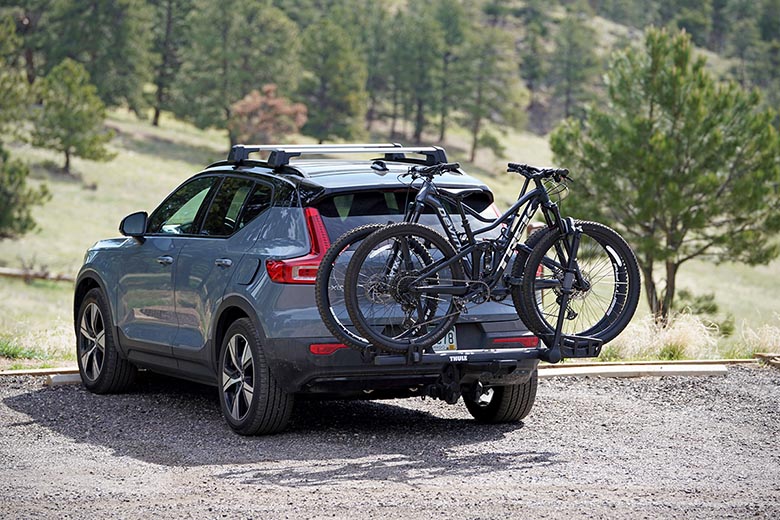
Switchback Travel


Switchback Travel
Price: $750
Number of bikes: 2 (4 with add-on)
Weight: 52 lb.
What we like: Loaded with features, well built, and very user-friendly.
What we don’t: Expensive and a bit heavy.
See the Thule T2 Pro XTR
Sweden-based Thule is one of the world’s leading manufacturers of car racks and bike accessories, and the T2 Pro XTR is their core hitch-mounted offering. An evolution of the popular T2 Classic, this is a fully featured rack with an easy-to-use tilt lever, integrated cable locks, and high-quality materials throughout. Additionally, the latest XTR model adds wheels on the bottom to help with off-the-hitch transport. Below we break down our experience with this extremely well-rounded design. To see how the T2 Pro XTR stacks up to the competition, check out our article on the best hitch bike racks.
We’ll get straight to the point: Thule’s T2 Pro XTR is the best hitch-mounted bike rack we’ve ever used. That’s a bold claim, but we have yet to find another model that combines all of the features you could possibly need into such a thoughtfully designed and durable package. The T2 Pro XTR includes an easy-to-use tilt lever, sturdy ratcheting arms, built-in locking system, and has the ability to carry almost any type of bike. Both the latest XTR (released in 2021) and its predecessor XT have held up well to all of our tests—our XT model is still going strong after 3+ years of use. We've added more weight than advised (more in “Bike Capacity” below), and subjected them to countless outings with everything from electric bikes to fat bikes. If you’re looking for one hitch-mounted rack to rule them all, we think the T2 Pro XTR is it.
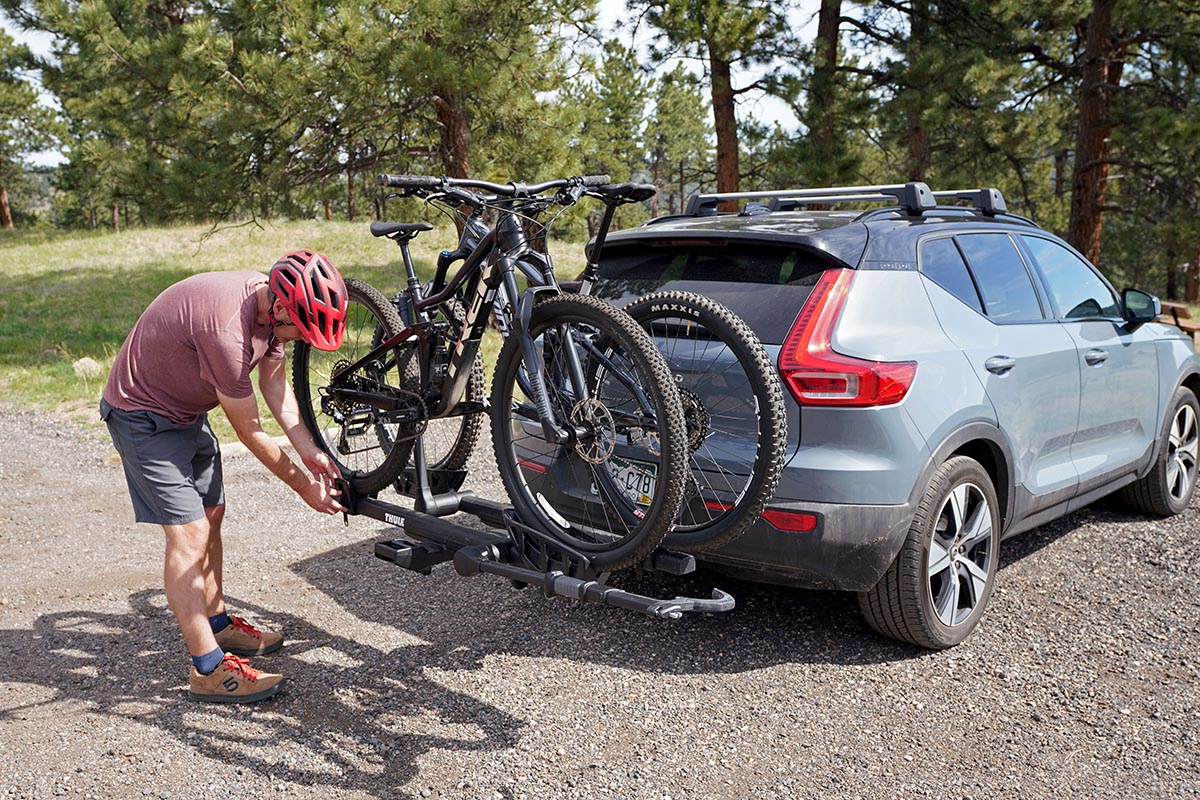
Like most platform-style bike racks, the T2 Pro XTR required some assembly before we could put it to use. Compared to similar models like the Kuat NV Base 2.0, it took us slightly longer to set up (about 25 minutes with the included tool). One thing to note is that there are some attachment intricacies, mainly with the front wheel cradles. Specifically, make sure to pay attention to the direction they’re facing as you mount them. We accidentally did it backwards the first time around, but the mistake was quickly and easily remedied once we realized the issue.
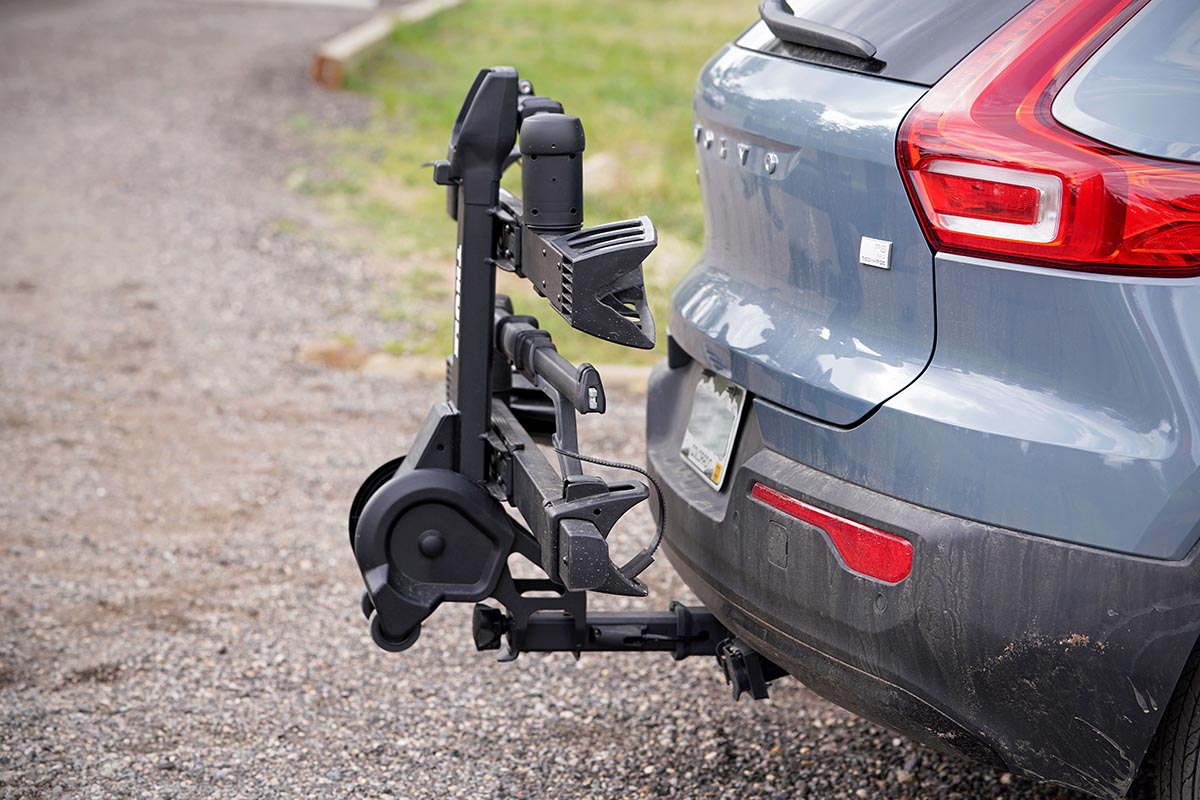
One of the big perks of platform-style hitch bike racks is how easy they are to use, and the T2 Pro XTR is a shining example of that. Loading and unloading bikes is a breeze, taking no more than 10 seconds per bike (yes, we timed it). We also found the ratcheting arms to be very user-friendly: Simply place the bike on the rack, lift the arm up and over the front wheel, then pull down on the handle until it cinches on the tire. The rear strap is equally intuitive: After the front wheel is secure, loop the strap over the wheel and pull down. Despite heavy use and concerted attempts to find flaws in the design, we have no criticisms to report here.
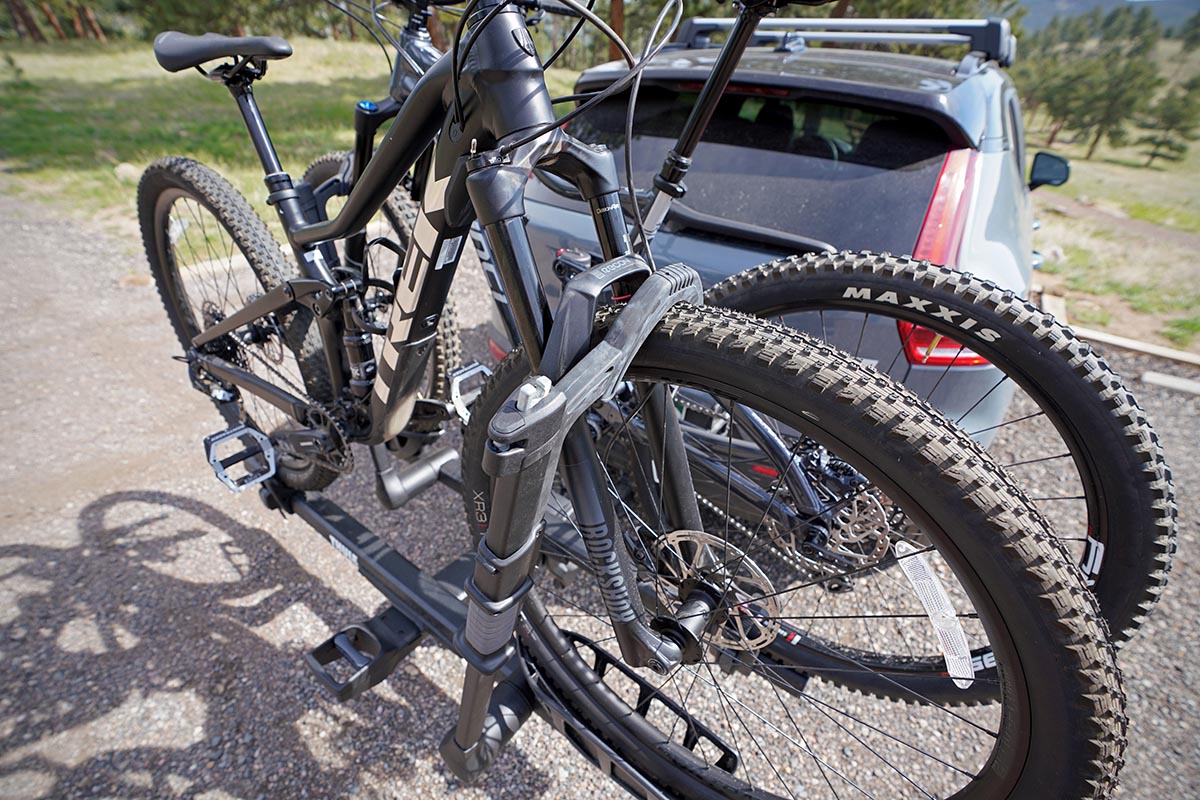
As with most platform hitch racks, the T2 Pro XTR—both the 2-inch and 1.25-inch receiver models—can handle two bikes. But what sets the T2 Pro XTR apart is its ability to carry a wide range of two-wheelers without adapters. With generous cradles that can accommodate tires up to 5 inches wide, you can carry fat bikes, mountain bikes, road bikes, and kids’ bikes with at least 20-inch wheels. Most other platform racks (we’re looking at you Yakima, Kuat Racks, and 1Up USA) require purchasing additional hardware and swapping parts to achieve the same versatility. And if two isn’t enough, you have the ability to double the rack’s bike capacity with a separate add-on (of note: This is only available for the 2-inch receiver model). But the extra capacity doesn’t come cheap at $500 (putting you at $1,250 all in).
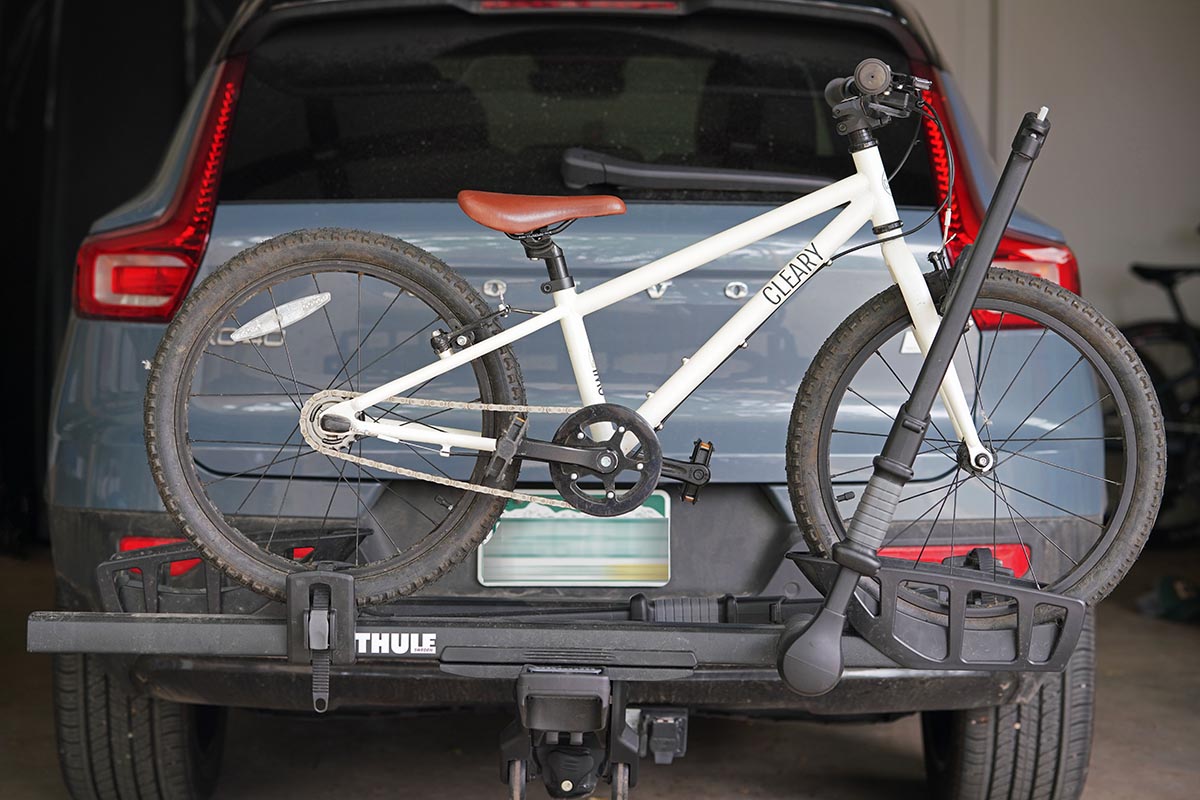
In terms of weight capacity, the T2 Pro XTR is able to handle two 60-pound bikes, which is the same or better than the competition. We don’t recommend following our lead, but we did test the limits of the rack with two electric bikes (on the prior-gen XT), each weighing around 65 to 70 pounds. We only transported them about 60 miles total, but we didn’t notice anything concerning, and the rack seemed to handle the additional weight with ease. The only negative part of the experience was awkwardly lifting the bikes up and onto the rack, a task definitely intended for two people (for e-bike users, it might be worth checking out a rack like the Thule EasyFold XT 2, which includes deployable ramps).
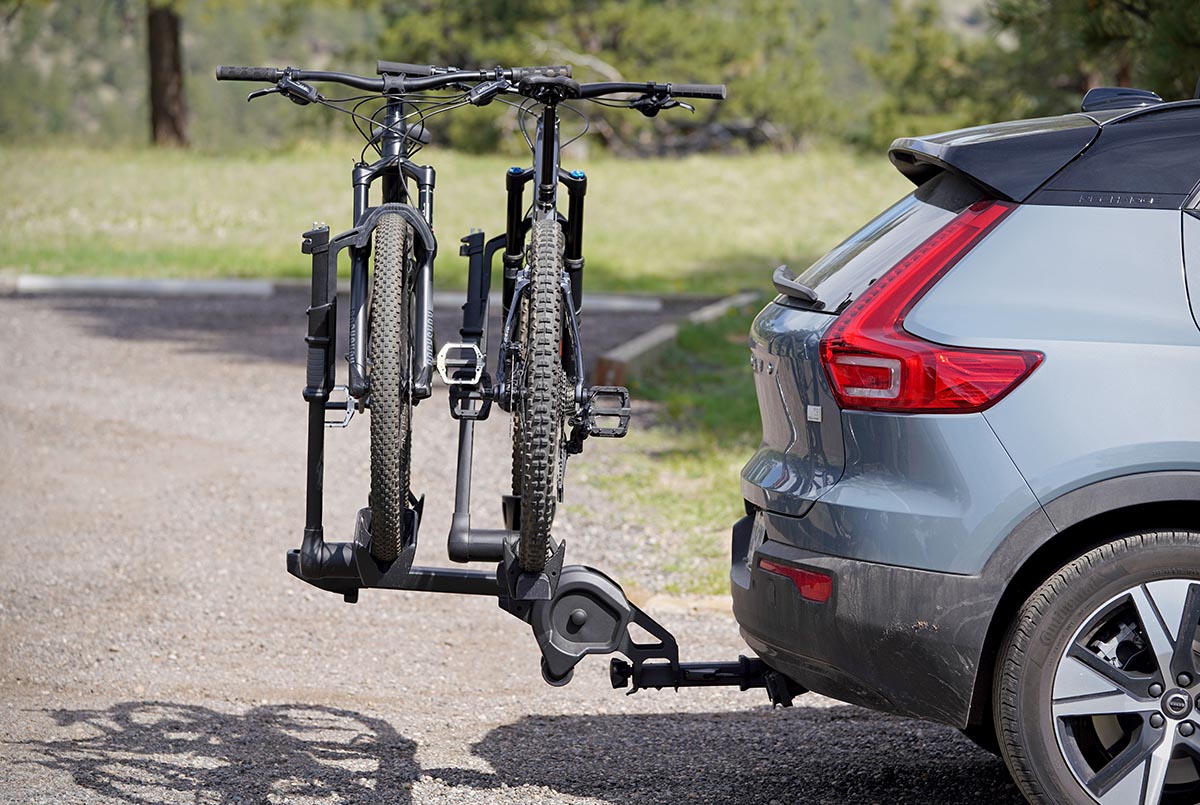
As expected from a high-end hitch bike rack like the T2 Pro XTR, Thule didn’t skimp on quality materials. It’s easily one of the heaviest-duty racks we’ve used and noticeably more rugged than the brand’s own Helium Platform. Build-wise, the T2 Pro XTR’s metal frame is stout, and its plastic cradles and smaller parts feel just as burly. In fact, the only platform model that we’ve tested that outdoes the Thule in the durability department is 1Up USA’s Heavy Duty Double with its all-metal construction.
Throughout our 3+ years of testing between the XT and XTR racks, we’ve only had one very minor (and easily repaired) issue. Namely, the tiny screw that holds the tilt lever handle in place came loose, so we simply put a drop of Loctite Threadlocker Blue 242 on the threads and it’s been problem-free for more than a year since. All in all, we’re confident in saying that although the T2 Pro XTR may be pricey and relatively heavy, the long-term value of this rack is exceptional.
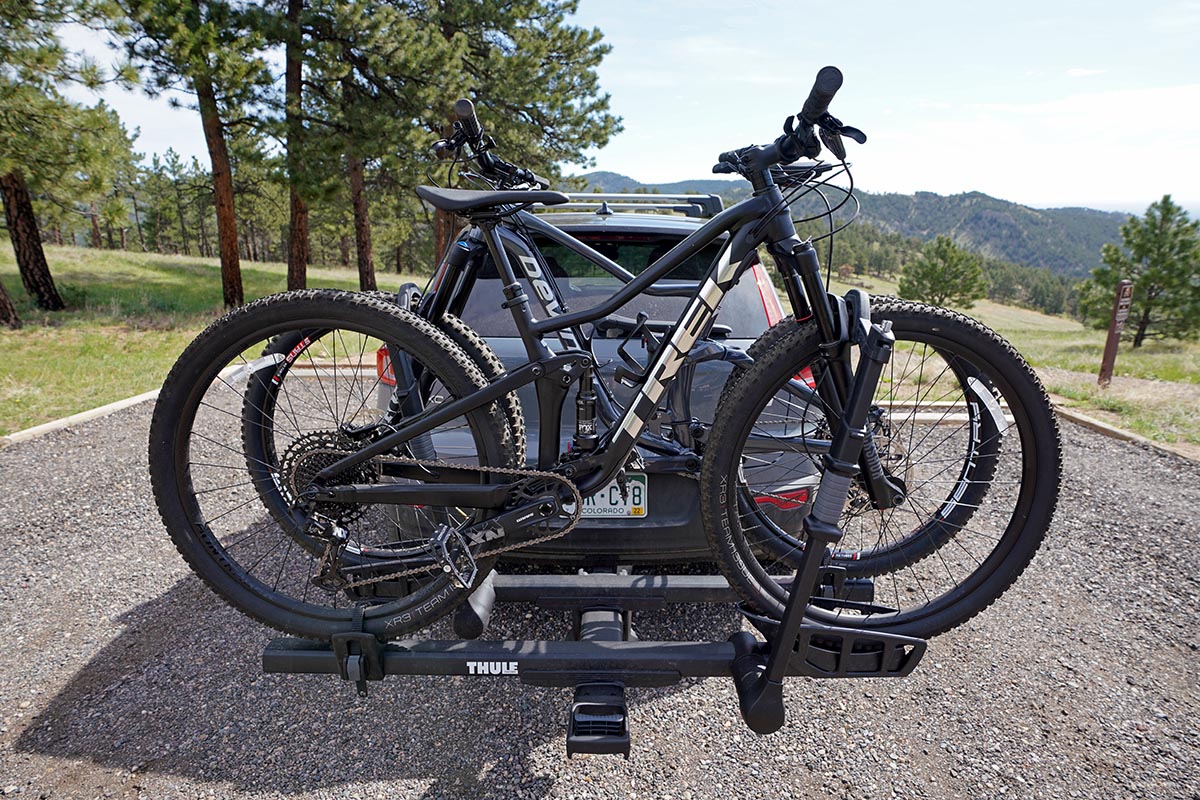
Weight always is a concern with bulky hitch racks, and Thule’s T2 Pro XTR is on the heavier end of the spectrum at 52 pounds. However, this is pretty much on par with other top racks, plus it’s a result of all the quality metal and components in the build. For comparison, Kuat’s NV 2.0 also comes in at 52 pounds, while 1Up USA’s Heavy Duty Double and Thule's Helium Platform 2 shave off some weight at 46 pounds and 43 pounds 2.3 ounces respectively. The only real standouts in this category are Kuat’s Transfer v2 (37 lb.) and Sherpa 2.0 (32 lb.). That said, weight-saving comes at a cost—namely, durability—and we will happily tote a few extra pounds if it means a longer lifespan.
In our opinion, the T2 Pro XTR’s ratcheting arms are some of the sturdiest in the business and easily put our obsessions about bike movement at ease. Even when deliberately pulling them side to side, the arms feel very secure and there was little to no give. And this theme continues with the rest of the system: The top arm that compresses against the tire tightens down snugly on everything from road to fat bikes, giving a nice, confident clicking sound as it locks, and the handle is thick enough to withstand adequate force. In addition, the rear wheel restraint is similarly easy to use and sturdy, with deep notches in the strap itself, a lever for cinching it down, and two stopping locations (the first works well for standard road and mountain bikes and the second for fat bikes). On most other platform racks, you simply pull the strap tight with your hands, but we really like having the mechanical advantage of the lever as it provides a little extra security.
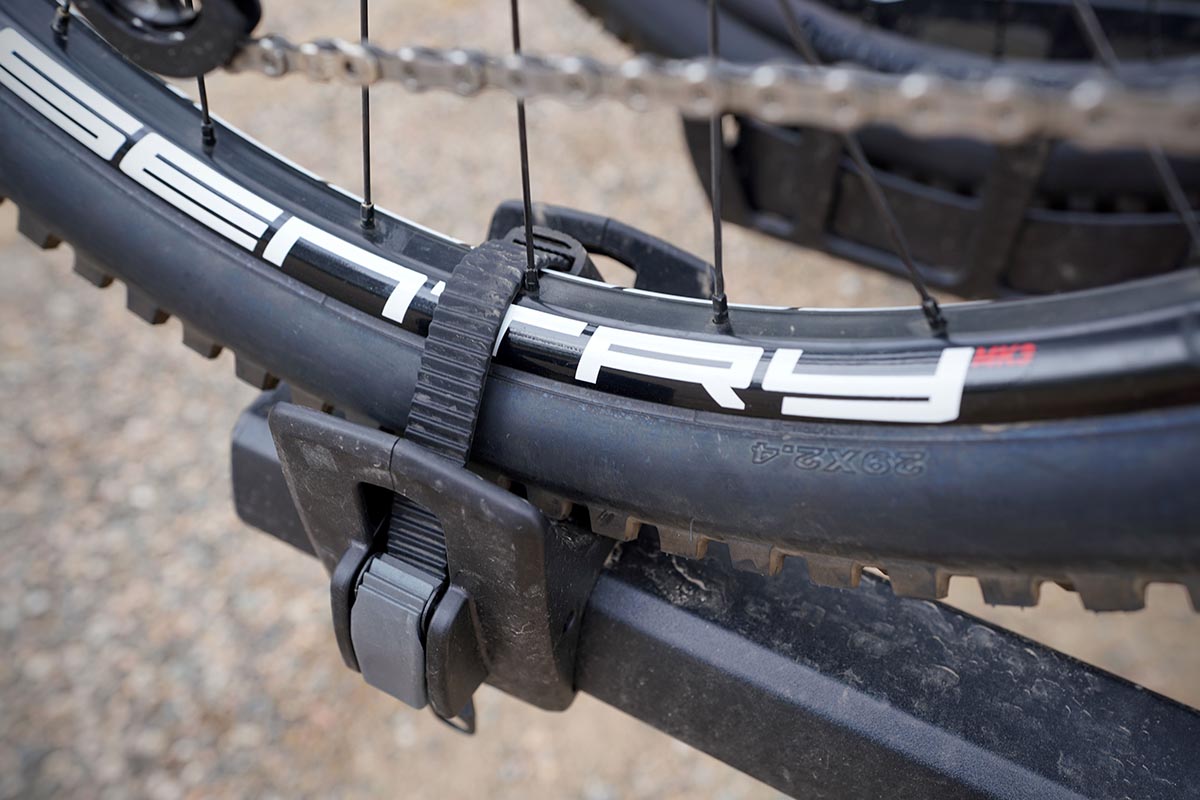
The only nitpick that we have with the system is that it doesn’t completely eliminate the risk of scuffs on a bike's front fork. Because the front arm needs to be secured close to the fork on your bike to keep things snug, there’s a chance the arm could rub over time or on rough roads. That said, we haven’t experienced any of the aforementioned problems. But those who are especially in tune with the condition of their bike may prefer the tire-only contact that you get with Thule’s own Helium Platform or 1Up’s Heavy Duty Double.
Thule’s tilt system, which they call the HitchSwitch Lever, is ideally placed for adjustments. The lever is located in the middle of the rack, away from the car and bikes, and it’s one of the few that we’ve been able to reach with ease when the bikes are loaded. What impressed us most, however, was how effortless it was to tilt the rack and bikes up and down once the lever was disengaged. We’re not sure what kind of design magic (or simple physics) went into this feature, but somehow Thule managed to find a pivot point that made lifting and lowering the bikes simpler than any other system we’ve tested. For comparison, the tilt lever on the 1Up Heavy Duty Double is much harder to reach (1Up actually sells a tilt lever extender for an extra $99), as is the lever on the Kuat NV 2.0.
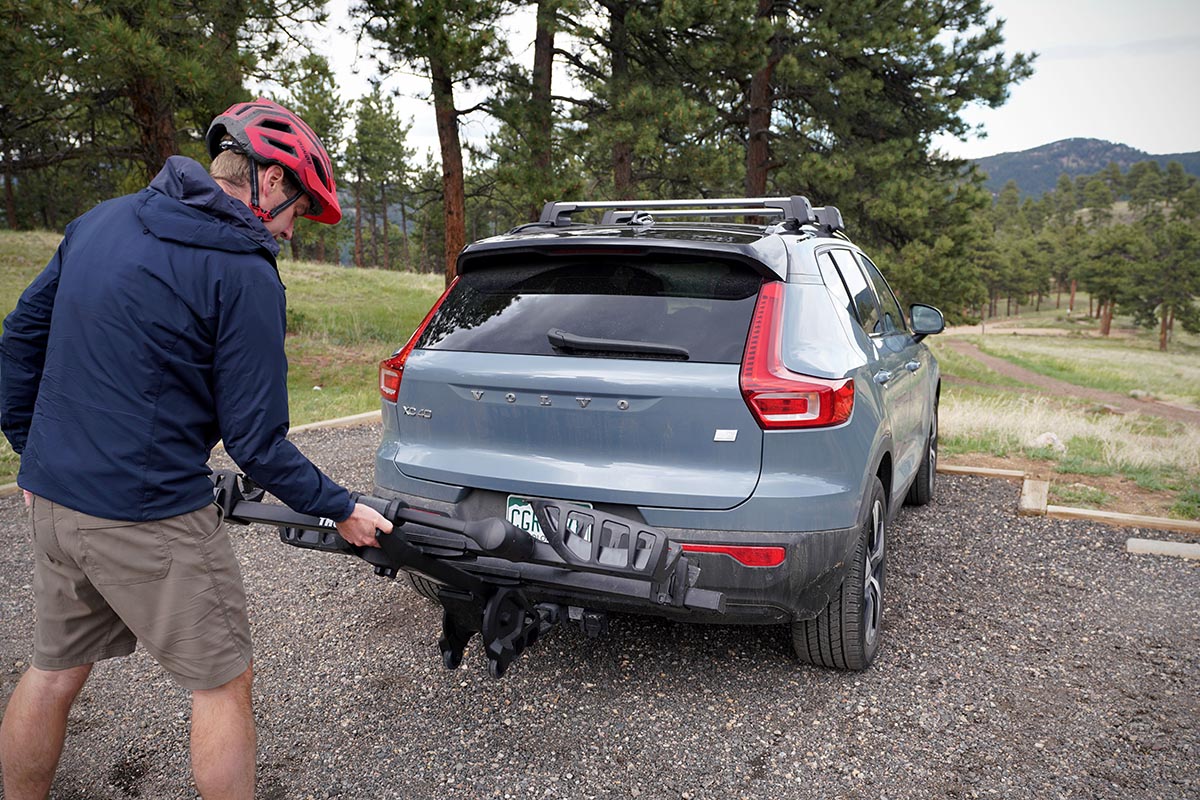
The only notable update from the XT to XTR version of the T2 Pro is the addition of a set of wheels along the bottom of the rack. For some people, the rack is light enough to remove from the hitch and carry to another part of your garage, but the wheels are undeniably helpful. To use them, you just set the T2 Pro XTR down on the floor, tilt it backward slightly, grab the pull handle, and the rack rolls around with ease. For longer hauls (perhaps to your car parked down the street from your house or storage unit), the wheels definitely make the process more seamless and are a nice addition to the T2 Pro.
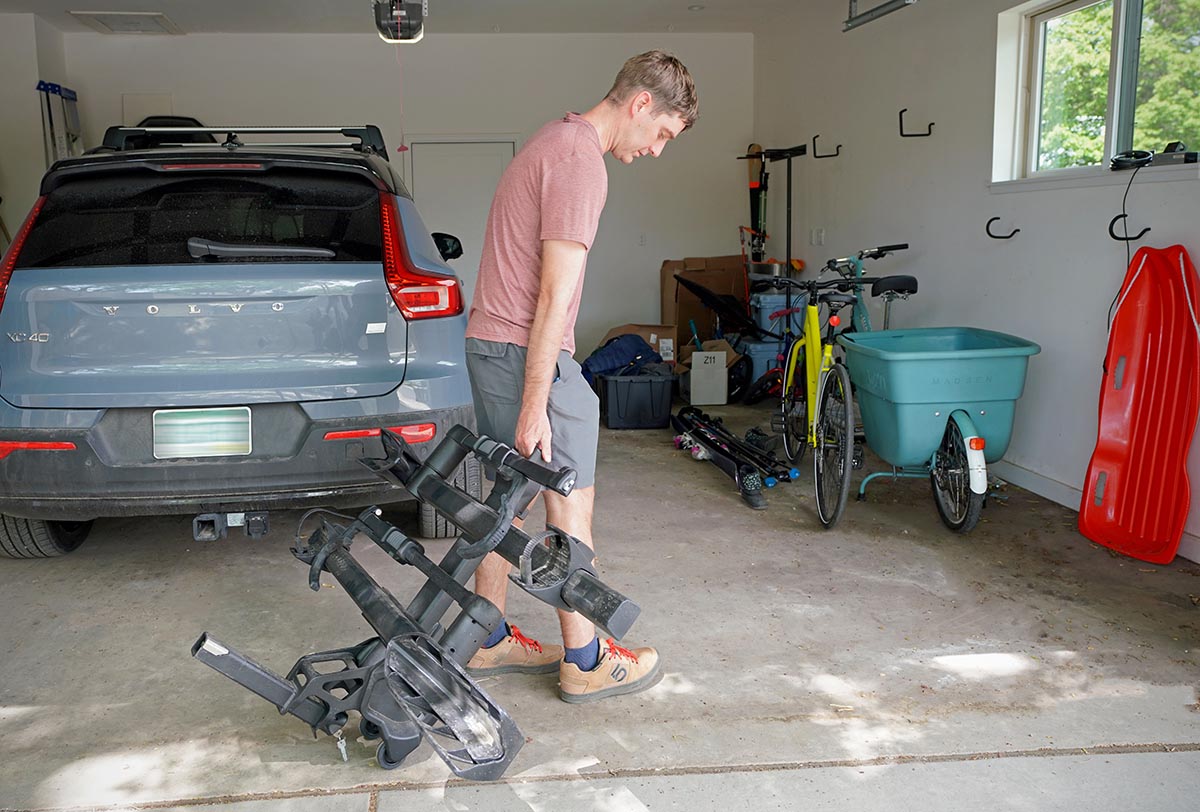
Many hitch-mounted racks include a locking system for your bikes and/or the rack itself, which is a nice touch and can save you money in the long run. On the Thule T2 Pro XTR, you’ll find an integrated lock at the end of each ratcheting arm, as well as on the expanding wedge knob that secures the rack to the vehicle. Given their location, we found that it was easiest to run the cable locks through the fork on each bike (or on the frame of our shorter-travel mountain bikes), but we weren’t able to secure them through the front wheel and frame at the same time—another six inches of length would have been ideal. But realistically, the cable locks are only meant for very short stops, as a pair of bolt cutters would make quick work of them. That said, we really came to appreciate the fact that all three locks were concealed and well-integrated into the rack, which meant there was no need to wrangle extra cables in our vehicle.
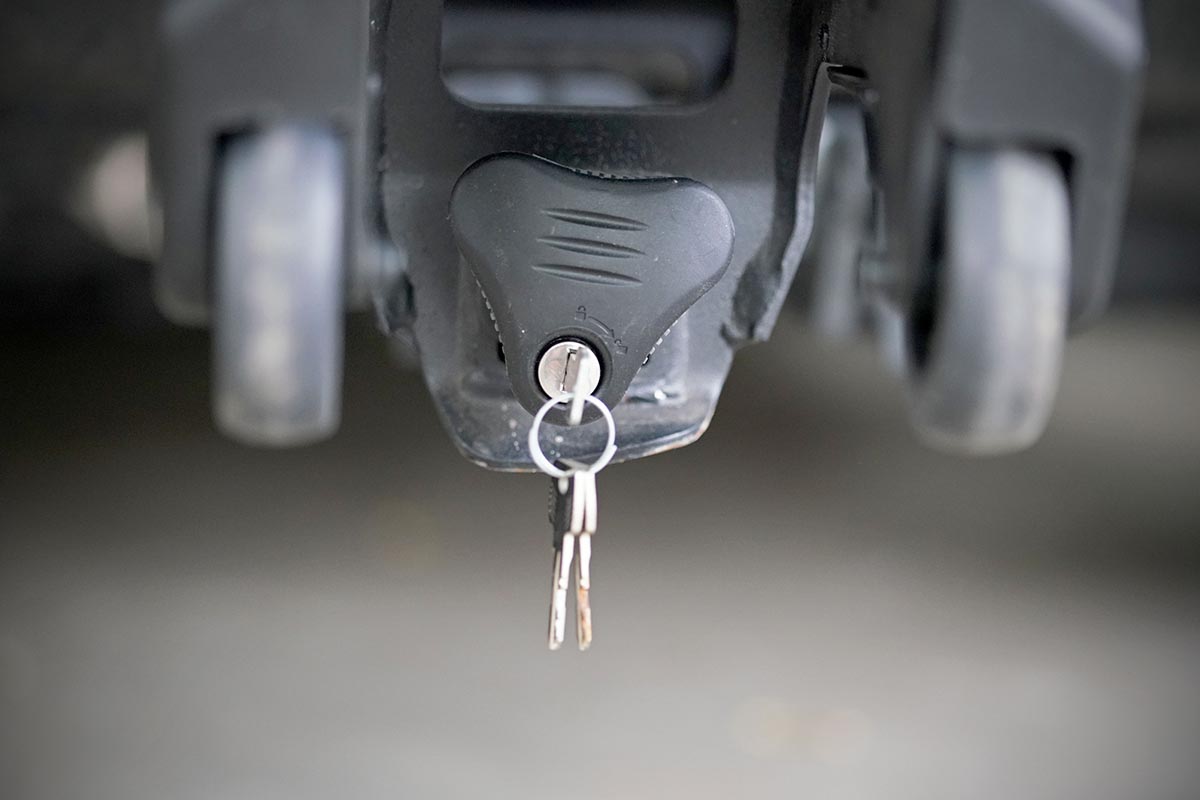
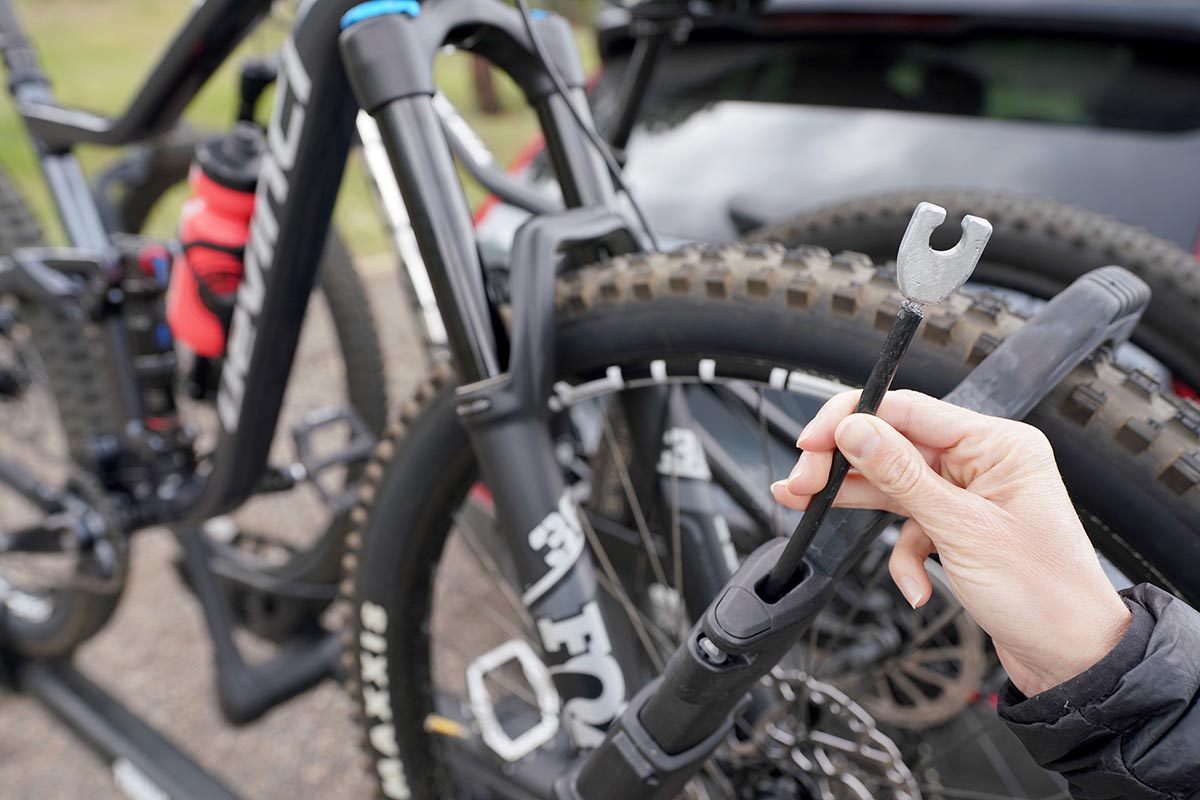
| Rack | Price | Weight | Tire Width | Wheel Sizes | Capacity* | Locks |
|---|---|---|---|---|---|---|
| Thule T2 Pro XTR | $750 | 52 lb. | 5 in. max | 20-29 in. | 60 lb. | Yes |
| Kuat NV 2.0 | $898 | 52 lb. | 3 in. max | 25-29 in. | 60 lb. | Yes |
| Kuat Transfer v2 | $489 | 37 lb. | 3 in. max | 18-29 in. | 60 lb. | Yes |
| 1Up USA Heavy Duty Double | $650 | 46 lb. | 3.1 in. max | 16-29 in. | 50 lb. | No |
| Yakima StageTwo | $799 | 66 lb. | 3.25 in. | 20-29 in. | 70 lb. | Yes |
| Kuat Sherpa 2.0 | $689 | 32 lb. | 3 in. max | 25-29 in. | 40 lb. | Yes |
*Editor's note: "Capacity" refers to weight capacity per bike.
The T2 Pro XTR is currently our favorite hitch-mounted bike rack, but there are a number of viable competitors. With their NV 2.0, Kuat makes a solid effort at dethroning the Thule and comes pretty darn close. The NV is a solid, sturdy-feeling rack that checks all the right boxes for a lot of riders—and even comes with some useful extras like an integrated repair stand. That said, the Kuat requires an adapter to truck around fat bikes or 20- to 24-inch wheels, which the Thule can do out of the box (note: The adapter is free, but you will need to request it through Kuat). The Thule also wins out on ease of access to the tilt mechanism. Tack on the nearly $150 price difference, and despite the NV’s nice styling and quality build, we give the T2 Pro the slight edge.
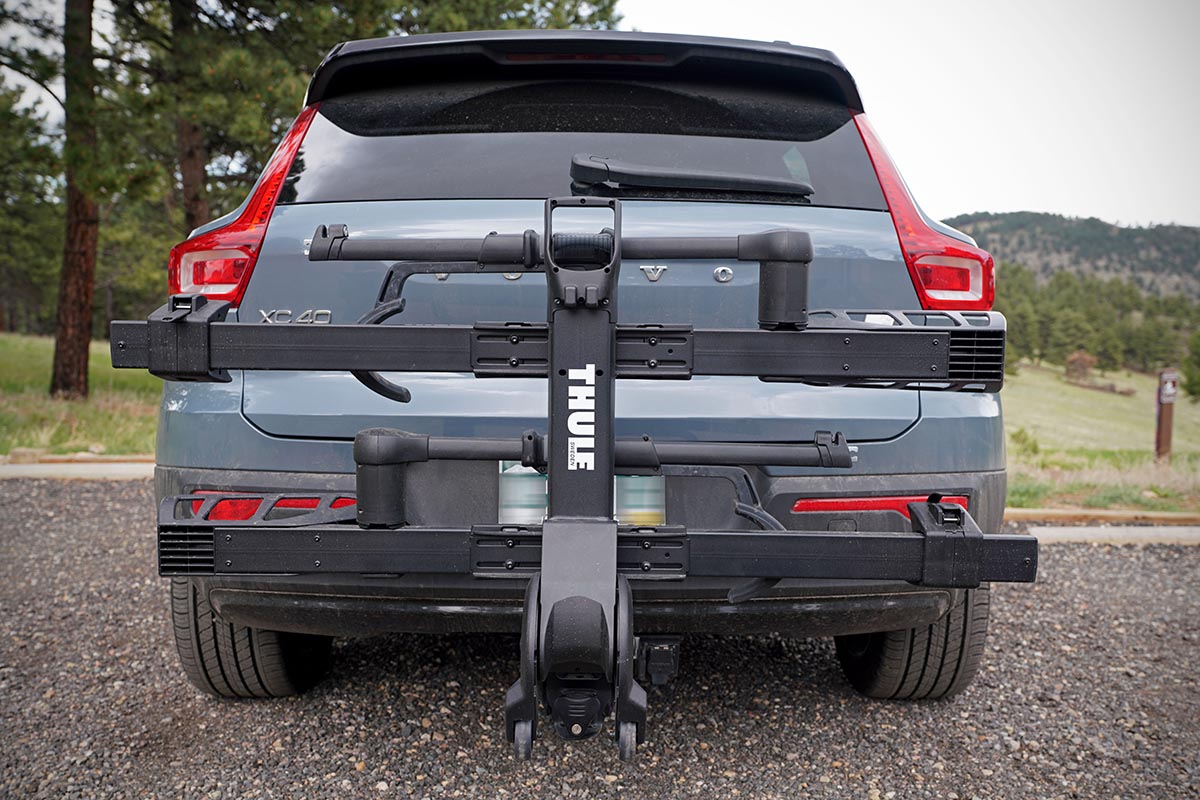
Kuat’s Transfer v2 is another solid and popular offering from the brand that undercuts the T2 Pro in price by more than $250 and weight by 15 pounds. However, while the rack does share many features with the Thule—it hauls two bikes without frame contact and features a tilt mechanism for rear cargo access—the slash in price does come with some downsides. Most notably, the Transfer's materials are a step down in quality: Our model has developed squeaks after year-round use, and we’ve noticed the tilt lever is prone to sticking. That said, the Kuat still is a solid all-around option at an attractive price point, especially for those who only haul bikes occasionally (for more, see our in-depth Transfer v2 review).
For serious riders, Wisconsin-based 1Up has a significant following. We’ve really enjoyed testing their Heavy Duty Double, which wins out in durability with a unique all-metal build that comes in 6 pounds lighter than the T2 Pro XTR. That said, it can’t haul as much weight as the Thule (it can carry two 50-pounders) and requires an adapter (sold separately) for any bike with tires wider than 3.1 inches (the T2 can accommodate up to 5-in. tires). In addition, the tilt lever location makes it a bit awkward to use: You have to reach under any mounted bike to lower and reset it. Lastly, the Heavy Duty Double is bereft of any locking mechanisms for bikes. If you can live with those downsides, the silver version of the 1Up will save you a considerable $100 (the black version will save you $50).
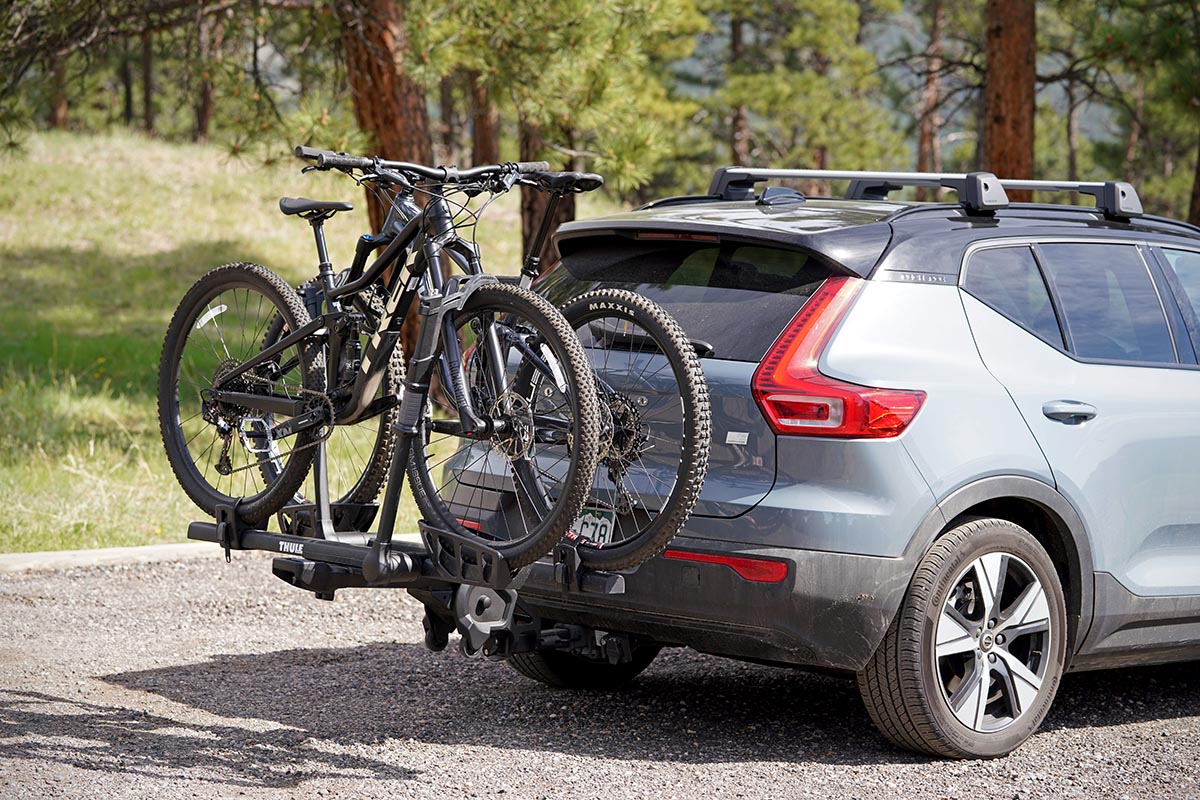
Yakima has been a trusted name for vehicle racks of all kinds for more than four decades—and their hitch racks are no different. Their StageTwo, in particular, stands out as a quality competitor to the T2 Pro. For about $50 more, the StageTwo features a solid and durable build that can haul 10 pounds more per bike than the Thule and offers an array of comparable features, including the ability to offset trays to avoid bike-on-bike contact. That said, the setup process requires some patience and precision, and the rack itself is much heavier than the T2 Pro at 66 pounds (plus, it lacks the Thule’s wheels for moving around). If you’re planning to haul heavy e-bikes, the Yakima gets our vote. Otherwise, we’d opt for the slightly cheaper and more feature-rich T2 Pro.
Finally, the Sherpa 2.0 is yet another popular option from Kuat—and the lightest alternative here at just 32 pounds. For about $60 less than the Thule, the Sherpa offers a compelling lightweight package if you’re hauling road or mountain bikes. The weight savings do come with some sacrifices, though. Most notably, the rack can only handle two 40-pound bikes with up to 3-inch tires (like the NV 2.0 above, it also requires an adapter for 20- to 24-in. wheels). We’ve also found that the weight savings equate to far less long-term durability than you get with the T2 Pro (our rack has had a couple of component failures, along with rusting out). In our opinion, the Thule is absolutely worth the extra $60. And if cost isn't a factor, Kuat's Piston Pro X includes everything we like about the T2 Pro, plus built-in LED taillights, a rugged metal build, and hydro-pneumatic cradle arms.
If you’re thinking about buying gear that we’ve reviewed on Switchback Travel, you can help support us in the process. Just click on any of the seller links above, and if you make a purchase, we receive a small percentage of the transaction. The cost of the product is the same to you but this helps us continue to test and write about outdoor gear. Thanks and we appreciate your support!
Depending on the seller, most products ship free in the United States on orders of $50 or more. International shipping availability and rates vary by seller. The pricing information on this page is updated hourly but we are not responsible for inaccuracies.